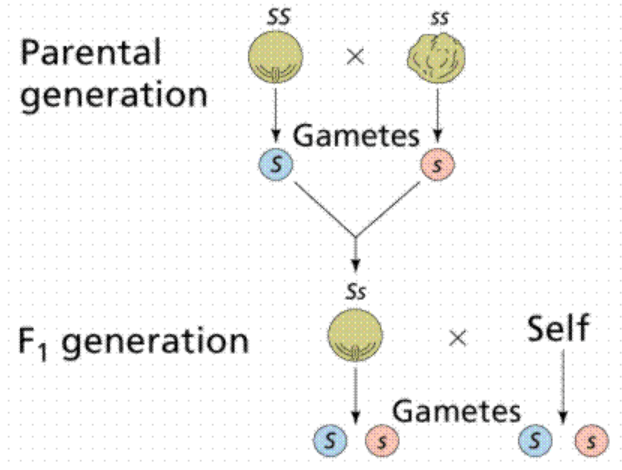
What is parental generation?
Answer
394.5k+ views
Hint: Gregor Mendel did his experiment including some important terms for his genetic studies and analysis. One of the terms is called the parental generation. Mendel takes two pea plants which produce two types of flower color that is white and purple. It is going under reproduction. The results comprise the parental generation. This type is called the monohybrid cross. It means only one trait is used to take for a test.
Complete answer:
Parental generation is the first set of parents crossed. Parental generation is known as the first offspring produced by the two individuals mated together. The resulting generation has three types. They are first generation, first filial generation and second filial generation. Parent generation is the true breeding of parental generation. \[F1\] Generation outputs are the hybrid types. \[F2\] Generation has the ratio of \[3:1\]. Filial means son. Mendel did their experiment on the pea plant. He crossed the pea plants which differed from each other in two traits. Plants of \[F1\] generation are self pollinated to produce a \[F2\] generation. Allele is called the different forms of genes. True breeding is defined as the parent repeatedly producing offspring with the same traits. \[P2\] and \[P3\] are known to be grandparents and great grand parental generations respectively. Parent’s genotype is used for predicting the genotype of offspring. Mendel proposed three laws for inheritance. They are the law of dominance, law of segregation and law of independent assortment.

Note:
The resulted output by the Mendel theory gives the recessive and dominant characters of the parent plants. During the cross fertilization process Mendel took two distinct plants. The final results shows that anyone of the parent not the combination of two. There are three important aspects to find the resulting output under the pollination. There are multiple trials for finding the patterns, a lot of variation in measurements of one experiment, and a large sample size. Offspring of the parent generation are called the first filial generation.
Complete answer:
Parental generation is the first set of parents crossed. Parental generation is known as the first offspring produced by the two individuals mated together. The resulting generation has three types. They are first generation, first filial generation and second filial generation. Parent generation is the true breeding of parental generation. \[F1\] Generation outputs are the hybrid types. \[F2\] Generation has the ratio of \[3:1\]. Filial means son. Mendel did their experiment on the pea plant. He crossed the pea plants which differed from each other in two traits. Plants of \[F1\] generation are self pollinated to produce a \[F2\] generation. Allele is called the different forms of genes. True breeding is defined as the parent repeatedly producing offspring with the same traits. \[P2\] and \[P3\] are known to be grandparents and great grand parental generations respectively. Parent’s genotype is used for predicting the genotype of offspring. Mendel proposed three laws for inheritance. They are the law of dominance, law of segregation and law of independent assortment.

Note:
The resulted output by the Mendel theory gives the recessive and dominant characters of the parent plants. During the cross fertilization process Mendel took two distinct plants. The final results shows that anyone of the parent not the combination of two. There are three important aspects to find the resulting output under the pollination. There are multiple trials for finding the patterns, a lot of variation in measurements of one experiment, and a large sample size. Offspring of the parent generation are called the first filial generation.
Recently Updated Pages
Master Class 12 Economics: Engaging Questions & Answers for Success

Master Class 12 Maths: Engaging Questions & Answers for Success

Master Class 12 Biology: Engaging Questions & Answers for Success

Master Class 12 Physics: Engaging Questions & Answers for Success

Master Class 12 Business Studies: Engaging Questions & Answers for Success

Master Class 12 English: Engaging Questions & Answers for Success

Trending doubts
What is the Full Form of PVC, PET, HDPE, LDPE, PP and PS ?

Draw a neat and well labeled diagram of TS of ovary class 12 biology CBSE

In fibre optics the signal source is waves A Light class 12 physics CBSE

What is shunt Explain its uses class 12 physics CBSE

Distinguish between asexual and sexual reproduction class 12 biology CBSE

Give five points to show the significance of varia class 12 biology CBSE




